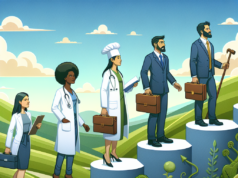
In an era characterized by rapid technological advancements and shifting societal norms, the workforce is undergoing a profound transformation. The dynamics of employment are being reshaped by various factors, including the rise of remote work, the integration of automation and artificial intelligence (AI), and the emergence of the gig economy. As organizations adapt to these changes, it is crucial for both employers and employees to understand the implications of these trends. This article delves into the current workforce trends that are redefining employment, highlighting the challenges and opportunities that lie ahead.
1. Introduction: Understanding the Dynamics of Workforce Transformation in the Modern Era
The modern workforce is experiencing a seismic shift, driven by technological innovation, demographic changes, and evolving employee expectations. Traditional employment models are being challenged as companies seek to enhance productivity and employee satisfaction. The COVID-19 pandemic accelerated many of these trends, forcing organizations to rethink their operational strategies and embrace flexibility. As we navigate this new landscape, it is essential to recognize the multifaceted nature of workforce transformation, which encompasses not only the methods of work but also the skills and competencies required for success in an increasingly competitive environment.
2. The Rise of Remote Work: How Telecommuting is Redefining Employment Norms
Remote work has emerged as a dominant trend, fundamentally altering the way we perceive employment. With advancements in communication technology and collaboration tools, employees can now work from virtually anywhere, leading to a significant shift in work-life balance and productivity. Organizations have begun to recognize the benefits of a remote workforce, including reduced overhead costs and access to a broader talent pool. However, this shift also presents challenges, such as maintaining team cohesion and managing employee performance. As remote work becomes a permanent fixture in many industries, companies must develop strategies to foster engagement and collaboration among dispersed teams.
3. Automation and AI: The Dual-Edged Sword of Job Creation and Job Displacement
The integration of automation and AI into the workplace is a double-edged sword, offering both opportunities for innovation and risks of job displacement. While these technologies can enhance efficiency and reduce operational costs, they also threaten to render certain job roles obsolete. Industries such as manufacturing, retail, and customer service are particularly vulnerable to automation, prompting concerns about the future of employment for millions of workers. However, it is important to note that automation can also create new job opportunities, particularly in fields related to technology development, data analysis, and AI management. As organizations navigate this complex landscape, a proactive approach to workforce reskilling and upskilling will be essential to mitigate the impact of job displacement.
4. The Gig Economy: Exploring the Shift Towards Freelance and Contractual Work Models
The gig economy has gained significant traction in recent years, driven by a desire for flexibility and autonomy among workers. Freelance and contractual work models allow individuals to pursue multiple income streams and maintain a better work-life balance. This shift has been facilitated by digital platforms that connect gig workers with clients, making it easier than ever to find short-term employment opportunities. However, the gig economy also raises important questions about job security, benefits, and workers’ rights. As more individuals opt for freelance work, policymakers and organizations must address these concerns to ensure that gig workers are protected and supported in their endeavors.
5. Skills of the Future: Identifying Essential Competencies for Tomorrow’s Job Market
As the employment landscape evolves, so too do the skills required for success in the job market. Employers are increasingly prioritizing competencies such as adaptability, critical thinking, and digital literacy. The ability to work collaboratively in diverse teams and navigate complex problem-solving scenarios is becoming essential. Furthermore, as technology continues to advance, proficiency in data analysis and AI will be crucial for many roles. Educational institutions and training programs must adapt to these changing demands by equipping individuals with the necessary skills to thrive in a dynamic workforce. Lifelong learning and continuous professional development will be key to staying relevant in an ever-changing job market.
6. Conclusion: Preparing for Change in a Rapidly Evolving Employment Landscape
In conclusion, the workforce is undergoing a significant transformation, driven by remote work, automation, and the rise of the gig economy. As these trends reshape employment norms, it is imperative for both employers and employees to adapt to the changing landscape. Organizations must embrace flexibility and invest in workforce development to remain competitive, while individuals must prioritize skill acquisition and adaptability to navigate the complexities of the modern job market. By understanding and preparing for these workforce trends, stakeholders can position themselves for success in an increasingly uncertain future. The ability to embrace change and innovate will be the hallmark of a resilient workforce, capable of thriving in the face of disruption.
As we look ahead, it is clear that the future of work will be defined by a blend of technological advancements and human adaptability. The trends discussed in this article serve as a roadmap for navigating the complexities of the evolving employment landscape. By fostering a culture of continuous learning and embracing new work models, both organizations and individuals can harness the opportunities presented by this transformation, ensuring a prosperous and sustainable future for the workforce.






















